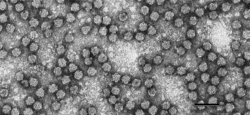Biology:Nanovirus
| Nanovirus | |
|---|---|

| |
| Faba bean necrotic yellows virus (FBNYV) | |
| Virus classification | |
| (unranked): | Virus |
| Realm: | Monodnaviria |
| Kingdom: | Shotokuvirae |
| Phylum: | Cressdnaviricota |
| Class: | Arfiviricetes |
| Order: | Mulpavirales |
| Family: | Nanoviridae |
| Genus: | Nanovirus |
Nanovirus is a genus of viruses, in the family Nanoviridae.[1] Legume plants serve as natural hosts. There are 11 species in this genus. Diseases associated with this genus include: stunting, severe necrosis and early plant death.[1][2][3]
Taxonomy
The following 11 species are assigned to the genus:[3]
- Black medic leaf roll virus
- Cow vetch latent virus
- Faba bean necrotic stunt virus
- Faba bean necrotic yellows virus
- Faba bean yellow leaf virus
- Milk vetch dwarf virus
- Parsley severe stunt associated virus
- Pea necrotic yellow dwarf virus
- Pea yellow stunt virus
- Sophora yellow stunt virus
- Subterranean clover stunt virus
Structure and genome
Virions in the genus Nanovirus are non-enveloped, with icosahedral and round geometries, and T=1 symmetry. The diameter is around 18-19 nm.
The genome is multipartite, and the genome components (6 or 8, depending on the genus) are circular, around 1kb in length, essentially carry only one gene, and are individually encapsidated forming small icosahedral virions (18–20 nm).[2][4]
| Genus | Structure | Symmetry | Capsid | Genomic arrangement | Genomic segmentation |
|---|---|---|---|---|---|
| Nanovirus | Icosahedral | T=1 | Non-enveloped | Circular | Segmented |
Life cycle
Viral replication is nuclear. Entry into the host cell is achieved by penetration into the host cell. Replication follows the ssDNA rolling circle model. DNA-templated transcription is the method of transcription. The virus exits the host cell by nuclear pore export, and tubule-guided viral movement. Legume plants serve as the natural host. The virus is transmitted via a vector (the virus does not replicate in this). Transmission routes are vector.[1][2]
| Genus | Host details | Tissue tropism | Entry details | Release details | Replication site | Assembly site | Transmission |
|---|---|---|---|---|---|---|---|
| Nanovirus | Plants: legumes | Phloem | Viral movement; mechanical inoculation | Secretion; viral movement | Nucleus | Nucleus | Aphids |
References
- ↑ 1.0 1.1 1.2 "ICTV Report Nanoviridae". http://www.ictv.global/report/nanoviridae.
- ↑ 2.0 2.1 2.2 "Viral Zone". ExPASy. http://viralzone.expasy.org/all_by_species/565.html. Retrieved 15 June 2015.
- ↑ 3.0 3.1 "Virus Taxonomy: 2020 Release". International Committee on Taxonomy of Viruses (ICTV). March 2021. https://ictv.global/taxonomy.
- ↑ Grigoras, Ioana (May 2014). "Genome diversity and evidence of recombination and reassortment in nanoviruses from Europe". Journal of General Virology 95: 1178–1191. doi:10.1099/vir.0.063115-0. PMID 24515973. http://jgv.microbiologyresearch.org/content/journal/jgv/10.1099/vir.0.063115-0#tab2.
External links
Wikidata ☰ Q18819832 entry
 |


